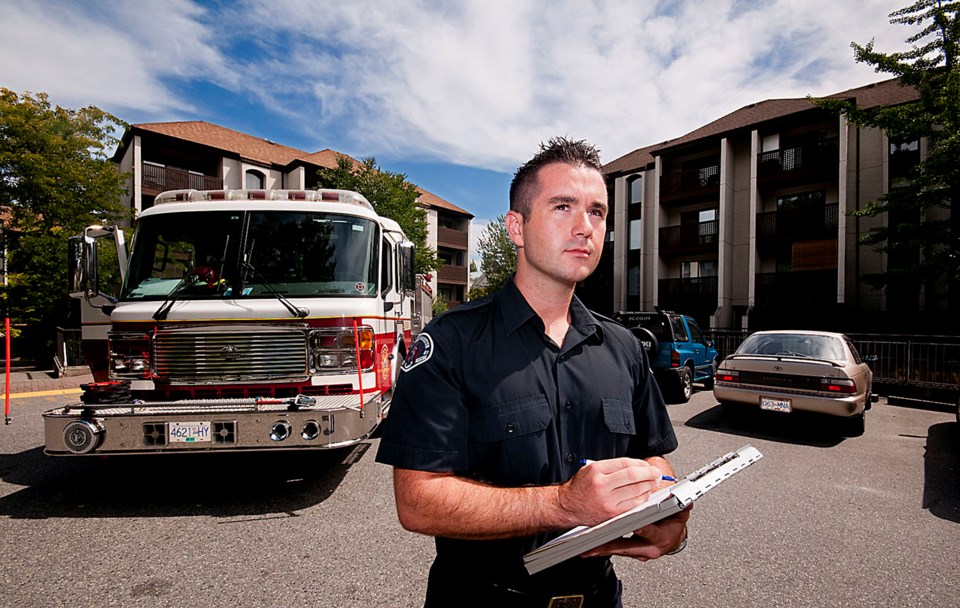An inspection program aimed at making sure lowrise apartment buildings are safe as possible is well underway.
Earlier this year, New Westminster Fire and Rescue Services established two task forces of firefighters to address the city’s inventory of buildings of five storeys or less. The Jan. 31 fire at a lowrise apartment at 404 Ash St., which destroyed the building and left about 36 tenants without homes, provided the impetus for creating two task forces with two firefighters each.
“We are just under halfway done,” said Deputy Fire Chief John Hatch. “It’s a two-year project.”
Inspectors and fire suppression crews also do inspections, but the bulk of the inspections being done on lowrise buildings are members of the task forces, which consist of firefighters who have been seconded to this special project.
“We have got about 470 properties that we have put into our inventory that we will be looking at in this task force,” said Deputy Chief Jim Wishlove. “To date, we have visited just over 41 per cent of them.”
The task force has been in operation since the end of April. The fire department and the firefighters’ union reached an agreement that allows inspections to be done seven days a week and at different times of the day.
“We are currently just finishing off what we consider the high-risk buildings, and then we’ll move on to the medium- and low-risk buildings,” Wishlove said. “We considered it a reasonable prioritization to get those done first.”
Looking at the 470 properties to be inspected, fire officials assessed the buildings’ risk level based on factors such as age of the building, the fire protection systems in place, the number of residents, and history of calls for service with respect to fires or alarms.
“If those numbers are high, then we consider the building high risk in our opinion, not so much that it is a danger to live there but we’d want to prioritize that inspection before a building that was brand new that had never had a call for service,” Wishlove explained.
During their visit, firefighters would look at items such as sprinklers, alarms and alarm panels, extinguishers and hose cabinets.
“We would also take a look at access, egress for the tenants. What we are really focusing on and trying to raise the awareness for building management folks themselves is the management of their own fire safety plan,” Wishlove said. “All of these buildings are obligated under the fire code to have a fire safety plan. In that plan, it is basically a user’s manual on how to manage your building with respect to having the systems inspected properly, conducting fire drills regularly, keeping those maintenance records and documentation in the fire safety plan.”
Of the inspections done to date by the task force, Wishlove said about half have been satisfactory and don’t require any followup at this time.
“The other half we are following up because there were items that need to be re-attended and followed up on,” he said. “They vary from anything that is really minor to something that is significant.”
Significant fire safety concerns for the fire department would be items such as a non-functioning alarm panel that has been faulty and needs immediate maintenance, fire doors that have been removed (perhaps to accommodate moving or ventilation) and cracks or missing ceiling tiles between floors or holes in walls where some maintenance or damage was done and hasn’t been repaired.
“That is a prime place for fire to spread from suite to suite,” he explained. “We typically like all of those tidied up so if there is a fire, it will be contained and allow our suppression crews to get there and suppress it easier.
The Ash Street fire highlighted the need for the fire department to take some “drastic, proactive action” on the inspection front, Wishlove said.
“I think, in many different aspects, it has been a brilliant process,” he said. “For our staff in particular, it’s been great. It’s really forced us into the community and to connect with these building management people and introduce ourselves and create that understanding and that relationship. It’s also given us a really clear picture as to the state of these properties and to see the general level of understanding with respect to the fire code and regulations. We have learned an awful lot about what’s going on in our community.”
On the other side of it, Wishlove said the process has created some understanding among management companies about why the fire department conducts these inspections and why various requirements are in place.
“It’s not simply because we are trying to be ogres and draconian,” he said. “There are really good practical reasons for these fire codes and the things they are asking.”



